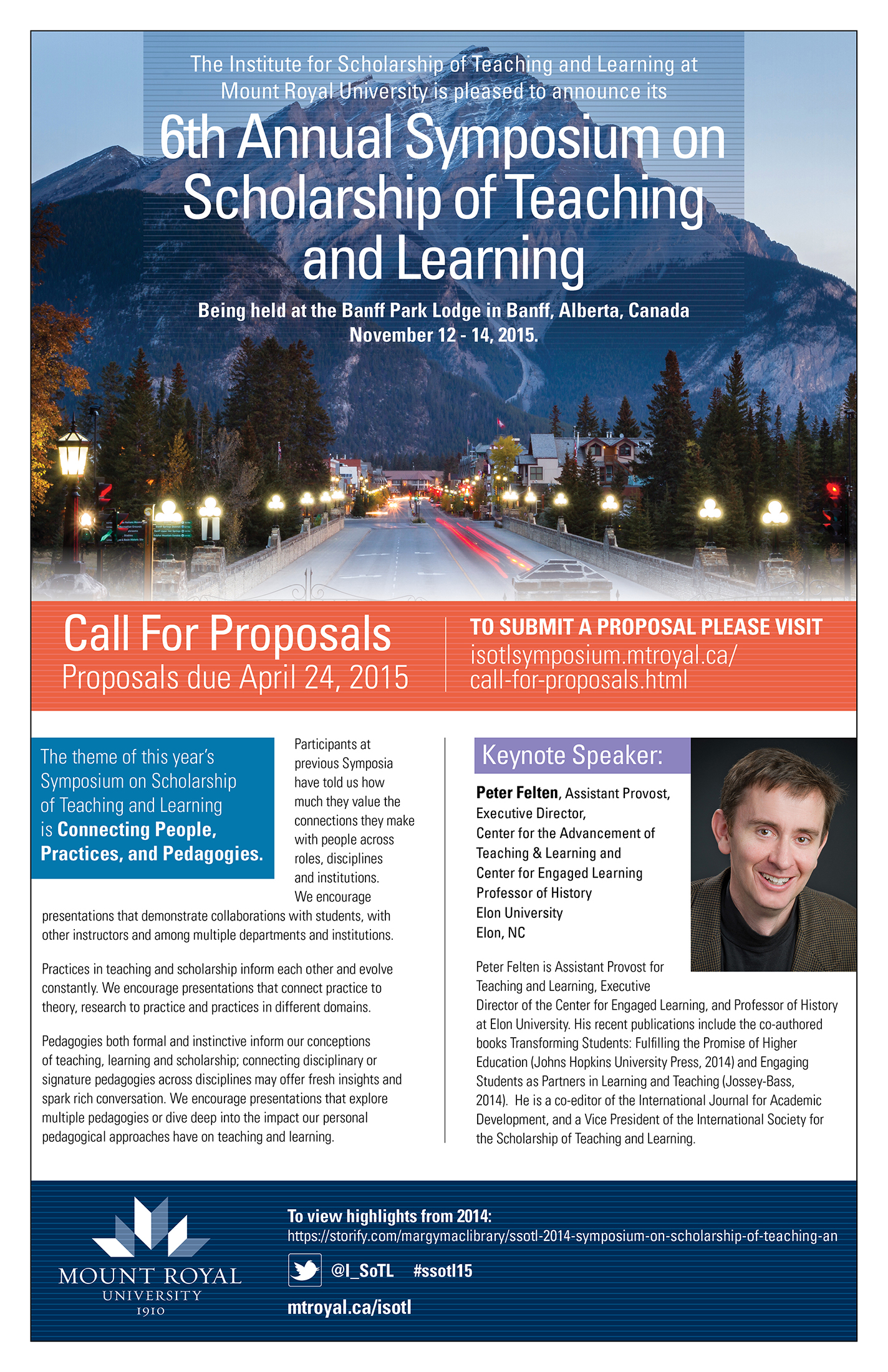New SoTL research underway
copied from MRU’s FaceTime article, March 17 2015:
What do stories, art, language and emotion all have in common? They are all related to classroom-based questions that the latest cohort of Teaching and Learning Scholars are developing and studying, supported by the Nexen Scholars Program and the Institute for Scholarship of Teaching and Learning (SoTL) at Mount Royal University.
“I know that MRU faculty are involved in many forms of scholarship related to teaching and learning,” says Director of the Institute for Scholarship of Teaching and Learning, Janice Miller-Young, PhD. “But depending on their time and experience, not everyone feels that they can or want to go it alone.”
The Nexen Scholars program offers not only structure and support for those who are developing research questions, which are focused on student learning, but also creates an interdisciplinary community for scholars to engage with as they design and conduct their research projects.
“In some disciplines and fields, community and collaboration are natural outcomes of the research culture, but scholarship related to teaching and learning can be isolating work unless we are intentional about connecting with a community,” adds Miller-Young. “Cultivating that community is one of the goals of the Institute and the program.”
Scholars supported by the Nexen Scholars Program have used a wide variety of approaches to study questions related to teaching and learning in Mount Royal’s classrooms. Some scholars have designed a specific intervention, such as a new assignment or a new pedagogical strategy, and then want to study how it works for the students.
For example, Bissett School of Business faculty members Brad Quiring and Collette Lemieux (2015 Nexen Scholars) are interested in developing case studies for teaching their introductory business statistics course. They know from experience and from the literature that students can memorize equations and perform well on an exam, but not necessarily understand the fundamental concepts of the course, nor how they can be applied in real life.
“There’s this voice in my head that’s been bothering me … am I making a difference?” says Quiring.
This collaborative teaching team hopes that through stories and case studies, students will develop statistical thinking skills and a better understanding of the course concepts, not to mention finding the class more engaging and relevant. Similarly, faculty member Joanna Szabo-Hart, PhD, (Nursing) and Curriculum Coodinator Sheri Rhodes,(International Education) are developing and studying new strategies to apply in the classroom.
2015 Nexen Scholars: (from back row left to right ) Sheri Rhodes, Pat Kostouros, Brad Quiring, Collette Lemieux, and Joanna Szabo-Hart
Szabo-Hart is interested in understanding how arts-based assignments might help her senior nursing students express and explore the art of nursing leadership, and Rhodes hopes that having ESL students listen to recordings of their own speech will help them notice different features of their own speaking.
“This program gives teachers time to focus and be mindful of our projects and also our teaching, which in turn is helping us be mindful of our students,” says Szabo-hart, for whom this is the second time through the program.
Despite what some might assume, SoTL doesn’t necessarily have to be about studying a specific teaching intervention. Other scholars, including Child and Youth studies faculty member Pat Kostouros, Phd, in the 2015 Nexen cohort, are more interested in getting a better understanding of what is already happening in a class.
Specifically, Kostouros will be drawing upon her disciplinary knowledge and expertise as a psychologist to understand students’ experiences of encountering the suffering of others in Sociology faculty member Tim Haney’s “Sociology of Disaster” class. Both Haney, PhD, and Kostouros believe that the inquiry into the practice of delivering materials that depict suffering is a practice that requires investigation.
“This is a variation on traditional SoTL research in that the teacher is not also the researcher,” says Janice Miller-Young. “But this approach opens up new possibilities for data collection such as interviewing students during the semester rather than waiting until the course — and power dynamic between the teacher and student — is over. To me, what makes this work SoTL is its potential to inform the teaching practice of both the teacher and the researcher, as well as their colleagues dealing with similar topics.”
After all, she concludes, informing and improving teaching and learning beyond a single classroom context are the primary goals of SoTL work.
Banff SoTL Symposium proposals due April 24
Reminder: Next SoTL presentation Tuesday March 17 on Scaffolding Undergraduate Research
Effects of a Scaffolded Approach to Undergraduate Research
Presented by:
Karen Manarin, Departments of English and General Education
Miriam Carey, Academic Development Centre
April McGrath, Department of Psychology
If undergraduate research leads to significant learning gains, should it be available to all students as part of the regular curriculum? Karen Manarin, Miriam Carey and April McGrath explore the effects of a scaffolded approach to undergraduate research in a 4th year English class, a 1st year General Education class, and a 2nd year Psychology class in this collaborative scholarship of teaching and learning project.
Tuesday, March 17, 2015
Noon – 1:00 p.m.
Room Y324
No registration required — everyone welcome!
Come and join in the conversation about teaching and learning.



